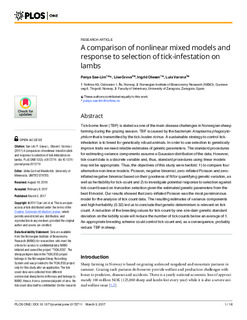| dc.description.abstract | Tick-borne fever (TBF) is stated as one of the main disease challenges in Norwegian sheep farming during the grazing season. TBF is caused by the bacterium Anaplasma phagocytophilum that is transmitted by the tick Ixodes ricinus. A sustainable strategy to control tick-infestation is to breed for genetically robust animals. In order to use selection to genetically improve traits we need reliable estimates of genetic parameters. The standard procedures for estimating variance components assume a Gaussian distribution of the data. However, tick-count data is a discrete variable and, thus, standard procedures using linear models may not be appropriate. Thus, the objectives of this study were twofold: 1) to compare four alternative non-linear models: Poisson, negative binomial, zero-inflated Poisson and zero-inflated negative binomial based on their goodness of fit for quantifying genetic variation, as well as heritability for tick-count and 2) to investigate potential response to selection against tick-count based on truncation selection given the estimated genetic parameters from the best fit model. Our results showed that zero-inflated Poisson was the most parsimonious model for the analysis of tick count data. The resulting estimates of variance components and high heritability (0.32) led us to conclude that genetic determinism is relevant on tick count. A reduction of the breeding values for tick-count by one sire-dam genetic standard deviation on the liability scale will reduce the number of tick counts below an average of 1. An appropriate breeding scheme could control tick-count and, as a consequence, probably reduce TBF in sheep. | |
